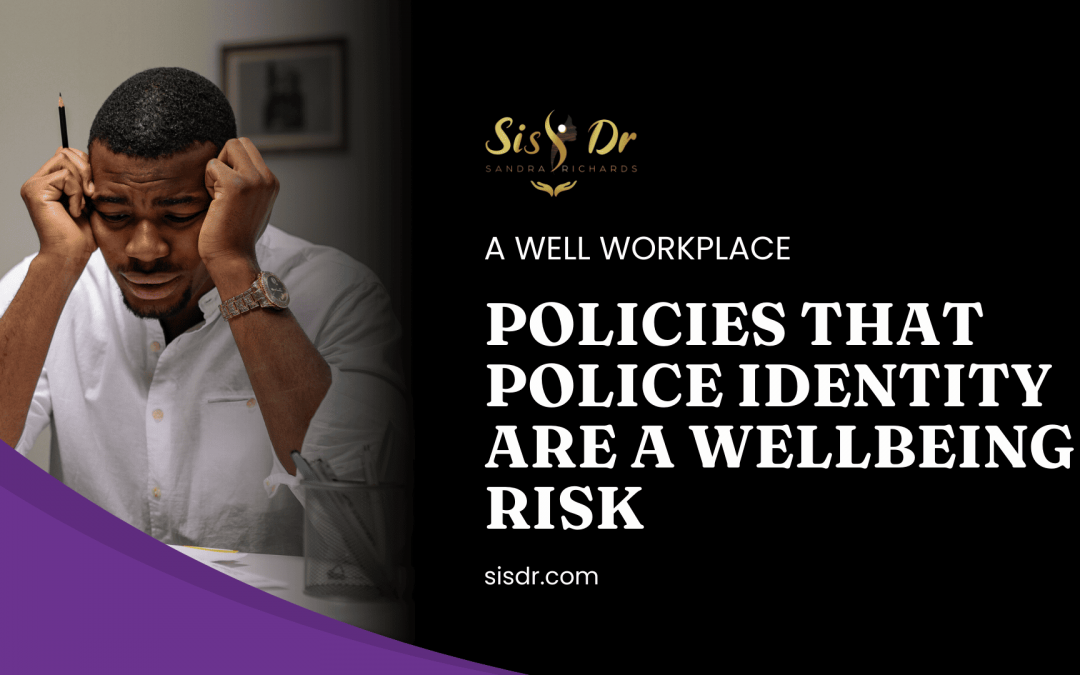In many workplaces, the concept of ‘professionalism’ is still shaped by narrow and often unspoken norms. Appearance standards, dress codes, and expectations about speech, body language, and behaviour are presented as neutral and universal.
In reality, these standards often reflect Eurocentric ideals and can send a clear signal to culturally diverse staff that their full identity is not acceptable within the professional environment.
Naturally, what begins as guidance around presentation can easily become a set of restrictions that require employees to filter out visible and audible aspects of their cultural heritage.
Over time, this requirement does not simply affect style or personal preference. It impacts mental health, engagement, and the ability to form meaningful, authentic connections at work.
The Wellbeing Cost of Policed Identity
For staff from Black, Brown, and other culturally diverse backgrounds, the constant need to adapt or “tone down” aspects of identity can have significant psychological and emotional consequences. These include:
Chronic stress responses:
Maintaining a constant state of self-monitoring to avoid perceived mistakes in appearance or communication can place the body under sustained stress, affecting both mental and physical health.
Identity suppression:
Reducing or hiding cultural markers such as hair texture, traditional clothing, language use, or religious symbols in order to avoid bias from colleagues or leaders.
Isolation and detachment:
Experiencing emotional distance from peers and leaders because authentic self-expression feels unsafe, which reduces the sense of belonging and inclusion.
These experiences are not simply a matter of personal discomfort. Prolonged suppression of identity is linked to increased anxiety, lower self-esteem, and a decrease in job satisfaction. It also undermines the trust between staff and the organisation, making genuine wellbeing initiatives much harder to embed.
Why This Matters for Organisations
When employees feel that their cultural identity must be hidden or altered in order to succeed, the impact is felt across the whole organisation. The consequences are tangible:
Lower engagement: Creativity, innovation, and collaboration often decrease when staff do not feel psychologically safe to contribute fully.
Higher turnover: Staff who cannot see themselves represented or valued within the organisational culture are more likely to seek employment elsewhere, creating avoidable recruitment and training costs.
Reduced trust in leadership: When leadership enforces or ignores policies that limit cultural expression, it sends a message that wellbeing is secondary to conformity.
Workplace wellbeing is not achieved by encouraging employees to ‘bring their whole selves to work’ while silently enforcing standards that contradict that invitation. It requires a structural and cultural shift.
What Organisations Can Do
1. Audit and review professionalism standards
Examine grooming, dress code, and communication guidelines in detail. Identify whether they privilege a specific cultural norm. Consider the lived experiences of staff from a variety of backgrounds to ensure that policies do not exclude or disadvantage them.
2. Embed cultural safety into policy language
Replace prescriptive rules about appearance with outcome-based standards, focusing on factors such as cleanliness, safety, and the practical requirements of a role. Ensure the wording explicitly allows for a variety of cultural expressions and practices.
3. Provide bias awareness training for leaders
Equip managers with the skills to give feedback without imposing personal or cultural bias. Leaders should be able to recognise when a comment about appearance, voice, or manner is a reflection of subjective preference rather than professional necessity.
4. Model inclusive practice from senior leadership
When senior figures within the organisation demonstrate comfort with their own cultural identity, and visibly welcome it in others, it creates permission for authenticity throughout the workforce. This modelling can have a powerful effect on workplace culture.
Wellbeing-Centred Culture
Removing restrictions that police identity is not an optional gesture of goodwill. It is a strategic decision that directly influences organisational health. A workforce that feels culturally safe is more engaged, more creative, and more resilient.
Psychological safety cannot exist in an environment where employees are required to mute, hide, or reshape significant aspects of who they are. By ensuring that policies are inclusive and respectful of cultural identity, organisations lay the groundwork for wellbeing initiatives that are not only well-received but truly effective.
The most important question for any organisation is not “How much cultural expression should we permit?” but rather “What might we gain if every employee could enter the workplace without leaving part of themselves behind?”
About SisDr (Dr. Sandra Richards)
SisDr is a Cultural and Wellbeing Practitioner, Counsellor, and Educator with over 30 years’ experience supporting women, men, families, and organisations. Her work blends psychological knowledge with cultural guidance, empowering individuals on journeys of emotional healing, identity reclamation, and transformational change.

